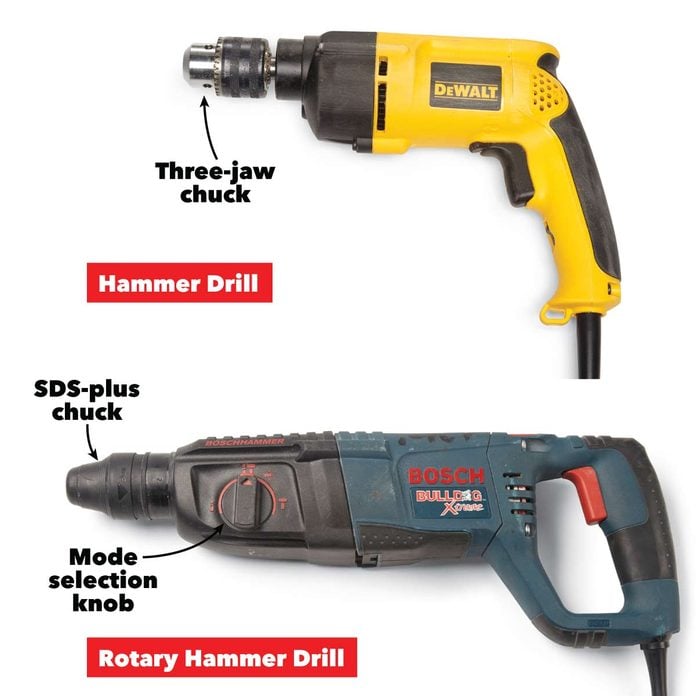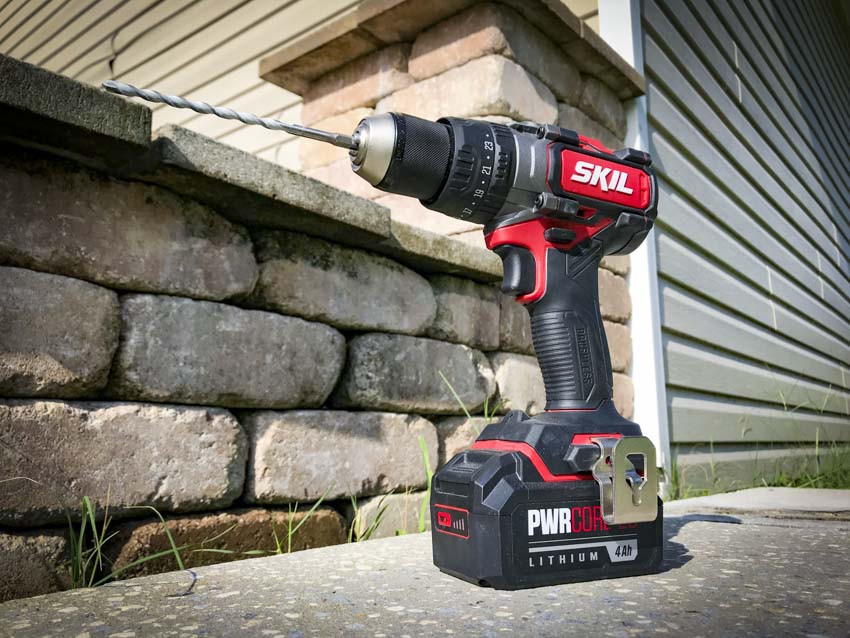A drill creates holes in materials using rotational force. A hammer drill combines rotational force with a hammering action.
Both tools are essential for various DIY and professional projects. A standard drill is ideal for wood, metal, and plastic. It offers precision and is perfect for tasks that require smooth, clean holes. On the other hand, a hammer drill is specifically designed for masonry and concrete.
It uses a hammering motion to break through tough surfaces, making it more powerful for heavy-duty tasks. Selecting the right tool depends on the material and project requirements. Understanding these differences ensures efficient and effective work, whether you’re hanging shelves or installing a concrete anchor. Use the right tool for optimal results.

Credit: www.familyhandyman.com
Basic Mechanisms
The basic mechanisms of a drill and a hammer drill differ significantly. Understanding these differences helps you choose the right tool for your project. Let’s break down how each tool works.
How Drills Work
A drill uses a motor to rotate a drill bit. This rotation creates holes in various materials like wood, metal, and plastic. The motor’s speed can be adjusted to control the drilling speed. Drills often have a clutch to prevent overdriving screws.
- Motor rotates the bit.
- Adjustable speed for precision.
- Clutch prevents overdriving.
Drills are perfect for tasks requiring smooth, clean holes. They are ideal for light to medium-duty projects. The simplicity of a drill makes it a versatile tool in any toolbox.
How Hammer Drills Work
A hammer drill combines rotation with a hammering action. This hammering action helps to break up hard materials like concrete and brick. It uses a special mechanism that moves the drill bit back and forth rapidly.
- Combines rotation and hammering.
- Effective on hard materials.
- Back-and-forth motion for extra force.
Hammer drills are ideal for heavy-duty tasks. They are essential for construction projects involving masonry. The added power makes hammer drills suitable for tough materials.
In summary, a drill is best for lighter tasks and a hammer drill excels in heavy-duty applications.
Power And Performance
The power and performance of a tool determine its effectiveness. Understanding these aspects helps choose the right tool for your needs. This section explores the differences between a drill and a hammer drill in terms of power levels and performance in various materials.
Power Levels
Drills and hammer drills have different power levels. A regular drill usually operates with lower power. It is suitable for light to medium tasks. Hammer drills, on the other hand, have higher power levels. They are designed for heavy-duty tasks.
Below is a comparison table for quick reference:
| Tool | Power Level | Best For |
|---|---|---|
| Drill | Low to Medium | Wood, Plastic, Soft Metals |
| Hammer Drill | High | Concrete, Masonry, Hard Metals |
Performance In Different Materials
The performance of these tools varies across different materials. A regular drill performs well in wood, plastic, and soft metals. It drills holes quickly and efficiently. But, it struggles with harder materials.
A hammer drill excels in harder materials like concrete and masonry. It has a hammering action that breaks up tough materials. This makes drilling through hard surfaces easier and faster.
Here are some key points:
- Drill: Best for softer materials.
- Hammer Drill: Best for harder materials.
Choosing the right tool based on material type ensures efficient work and better results.
Design And Build
Understanding the design and build of drills and hammer drills is essential. The design impacts their functionality and usability. Let’s explore the key design features of both tools.
Drill Design Features
Drills are designed for basic drilling and screwing tasks. They have a compact body for easy handling. The motor is typically housed in the main body. This keeps the tool balanced.
- Chuck: The chuck holds the drill bit in place. It is adjustable to fit various sizes.
- Grip: The grip is ergonomically designed for comfort during use.
- Speed Control: Most drills have a variable speed control for precision.
Hammer Drill Design Features
Hammer drills are designed for tougher tasks like drilling into masonry. They have a sturdier build to handle the extra force.
- Hammer Mechanism: This feature provides a hammering action in addition to rotation.
- Auxiliary Handle: Many hammer drills include a secondary handle for better control.
- Depth Stop: This allows for consistent drilling depth, important for precision work.
| Feature | Drill | Hammer Drill |
|---|---|---|
| Primary Use | Basic Drilling | Drilling into Masonry |
| Weight | Lightweight | Heavier |
| Additional Handle | No | Yes |
| Variable Speed | Yes | Yes |
Primary Uses
The difference between a drill and a hammer drill lies in their primary uses. Knowing the right tool for the job can save time and effort. Below, we explore the common applications of each tool.
Common Drill Applications
A standard drill is a versatile tool useful in various tasks:
- Woodworking: Drills create holes in wood for screws or bolts.
- Metalworking: With the right bit, drills can pierce through metal.
- Plastic: Drills easily make holes in plastic materials.
- Furniture Assembly: Drills help in assembling furniture pieces.
Drills are also great for DIY projects around the home. They offer precision and ease.
Common Hammer Drill Applications
Hammer drills are designed for more robust tasks:
- Masonry: Hammer drills can bore through concrete and brick.
- Heavy-Duty Construction: Ideal for building and renovation work.
- Stone: These drills can penetrate stone surfaces.
- Tile Removal: Hammer drills help in breaking tiles.
Hammer drills combine the rotational motion of a drill with a hammering action. This makes them perfect for tough materials.
| Tool | Primary Use |
|---|---|
| Drill | Wood, Metal, Plastic, Furniture |
| Hammer Drill | Masonry, Stone, Heavy Construction, Tile Removal |
Choosing the right tool depends on the material and task. Drills are great for lighter tasks. Hammer drills are for tougher jobs.
Pros And Cons
Understanding the pros and cons of drills and hammer drills helps in making an informed decision. Each tool has unique advantages and disadvantages. Let’s explore them below.
Advantages Of Drills
Drills are versatile tools perfect for everyday tasks. Here are some key advantages:
- Lightweight: Drills are easier to handle due to their lighter weight.
- Cost-effective: They are generally cheaper than hammer drills.
- Versatile: Suitable for drilling holes, driving screws, and more.
- Quiet Operation: Drills produce less noise, making them ideal for indoor use.
- Battery Life: They consume less power, extending battery life.
Advantages Of Hammer Drills
Hammer drills are designed for heavy-duty tasks. Here are their main advantages:
- Powerful: Hammer drills can handle tougher materials like concrete and brick.
- Dual Functionality: They offer both drilling and hammering functions.
- Efficiency: Faster drilling in hard materials saves time and effort.
- Durability: Built to withstand heavy usage.
| Feature | Drill | Hammer Drill |
|---|---|---|
| Weight | Lighter | Heavier |
| Cost | Less expensive | More expensive |
| Functionality | Basic drilling | Drilling and hammering |
| Noise Level | Quieter | Louder |
| Battery Life | Longer | Shorter |
Cost Considerations
Choosing between a drill and a hammer drill involves understanding their costs. Both tools vary in price based on features and brands. Knowing these differences helps you make a smart purchase.
Price Range Of Drills
Drills are generally more affordable. Basic models start at around $30. Mid-range drills cost between $50 to $100. High-end models with advanced features can reach up to $200.
| Type | Price Range |
|---|---|
| Basic Drill | $30 – $50 |
| Mid-range Drill | $50 – $100 |
| High-end Drill | $100 – $200 |
Price Range Of Hammer Drills
Hammer drills are usually more expensive. Basic models start at $70. Mid-range options range from $100 to $200. High-end models can exceed $300.
| Type | Price Range |
|---|---|
| Basic Hammer Drill | $70 – $100 |
| Mid-range Hammer Drill | $100 – $200 |
| High-end Hammer Drill | $200 – $300+ |
Choosing The Right Tool
Selecting the right tool is essential for any project. Drills and hammer drills serve different purposes. Knowing their differences helps you make the best choice. Let’s explore the key factors.
Factors To Consider
Several factors influence your choice between a drill and a hammer drill. Here are the most important ones:
- Power: Hammer drills are more powerful.
- Material: Drills work well on wood and plastic.
- Function: Hammer drills can drill into concrete.
- Weight: Drills are generally lighter.
- Cost: Drills are often cheaper.
Best Scenarios For Each Tool
Understanding the best scenarios for each tool is crucial:
| Tool | Best Scenarios |
|---|---|
| Drill |
|
| Hammer Drill |
|

Credit: www.youtube.com

Credit: www.protoolreviews.com
Frequently Asked Questions
What Is A Drill Used For?
A drill is used for drilling holes in various materials like wood, metal, and plastic.
What Is A Hammer Drill?
A hammer drill is used for drilling into hard materials like concrete and masonry with a hammering action.
How Do Drills And Hammer Drills Differ?
Drills are for softer materials, while hammer drills can handle tougher materials with their hammering action.
Can A Regular Drill Work On Concrete?
No, a regular drill lacks the hammering mechanism needed to efficiently drill into concrete.
Which Is Better For Diy Projects?
A regular drill is better for general DIY projects, while a hammer drill is ideal for heavy-duty tasks.
Conclusion
Choosing between a drill and a hammer drill depends on your project needs. A regular drill suits everyday tasks. For tougher materials like concrete, a hammer drill excels. Understanding their differences ensures you select the right tool. This can improve efficiency and results in your DIY or professional projects.
Recent Posts
Maintaining clean gutters is essential for preventing water damage to your home, and choosing the best ladder for cleaning gutters can make the job much easier and safer. With so many options on the...
Best Ladder for Cleaning Caravan Roof: Top Picks for You Every Adventure!
Today we will discuss the best ladder for cleaning caravan roof. Cleaning caravan roofs is one of the crucial tasks.After many days, a caravan roof can get dirty by debris, dirt, and grime. These can...
